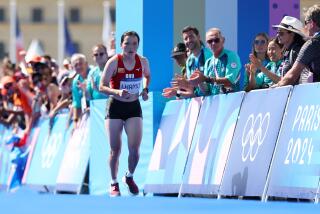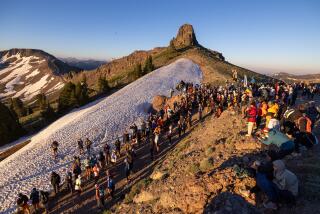Norway’s Kristiansen Strolls to Mini Marathon Win
- Share via
NEW YORK — These things are getting to be a walk in the park for Ingrid Kristiansen, these races with mere mortals. In Saturday’s L’Eggs Mini Marathon through Central Park, Kristiansen bolted to the lead a block into the race and left her competition wondering if they had been competition after all.
The 32-year-old Norwegian won the 10K race in 31 minutes 31 seconds, a good but not exciting time. But it was the manner in which she devastated the star-studded field--which included Mary Decker Slaney, Joan Benoit Samuelson, Anne Audain and Lisa Martin--that had the runners talking.
Asked to comment on Kristiansen’s race, Samuelson, who finished seventh in 33:05, said: “I really can’t comment. I didn’t see her after we made the turn into the park. Let’s say it was typically Ingrid.”
Kristiansen long ago stepped out of the shadow of countrywoman Grete Waitz. Kristiansen is the only person to have held world records in the 5,000, 10,000 and marathon at the same time. She also has world records at 15K, 10 miles and in the half marathon.
She is, in a word, remarkable. Her run Saturday was made more remarkable considering she decided to run here at the last minute and arrived late Thursday night, after 16 hours of travel and delays in her flight from Norway.
Still, Kristiansen was the favorite. Martin finished second, after breaking out of a pack of eight runners that followed 30 seconds behind Kristiansen.
The surprise of the race, and the bonus for nostalgia buffs, was the third-place finish of 35-year-old Francie Larrieu Smith, who began her career in track and field 20 years ago.
Slaney finished fourth.
To many, watching Larrieu and Slaney running side by side for the first half of the race was a flashback. The two have been in races together for years.
“I can’t say I ran with Mary in the middle distances,” Larrieu said. “Mostly, I ran behind her.”
In fact the two runners defined the middle distances for U.S. women in the ‘70s. Larrieu was a fixture on U.S. national teams, beginning in the late ‘60s. She is second only to Decker in terms of national titles--Larrieu has collected 18 in her 22-year career.
As do other runners when they discover they can run longer but not faster, Larrieu has moved up in distance. She made three Olympic teams at 1,500 meters but now will run the 10,000 and 3,000 at the U.S. Olympic trials. A hip injury prevented her from running in the marathon trials.
“I feel more comfortable with the 10K, but I’ll do the 3,000 and see how I feel,” Larrieu said.
Slaney is also in the 1,500 at trials but will concentrate on the 3,000.
As always, Slaney’s foremost concern is her health. She said that in order for her to double at the trials, conditions would have to be perfect. Here, conditions were excellent--overcast and 56 degrees--but the topography of the course gave Slaney pause.
“The hills concerned me; I don’t train on hills and there aren’t hills on the track,” Slaney said. “The hardest part was not the uphill but with the downhill part. I have a tendency to back off if there is a slight decline at all. It’s the hardest part on your legs and joints and, for me, I always have to be careful.”
Slaney, whose time was 32:18, looked strong through the hilly middle section of the race but also seemed content to let Larrieu (32:10) and Martin (32:04) pull away at the finish.
“I’m pleased with my race, I didn’t get hurt,” Slaney said.
For Martin, the move was one she wished she had made earlier.
Martin, an Australian who trains in Arizona, is a seasoned road racer and and will be among the favorites in the marathon at Seoul. She chose to follow Slaney in the early stages of the race, letting Slaney do the work but also banking that Slaney would direct the pack on the swiftest line to the finish.
“What a mistake,” Martin said, laughing. “I was thinking, ‘Mary’s experienced, she’ll run the tangents.’ She doesn’t know what a tangent is.”
Running the tangents is the shortest distance to the finish line. For example, cutting corners on turns.
“The field was turning right and Mary was going left,” Martin said. “I finally figured out that I should get out from behind her.”
For Slaney, it was a rare turn on the roads. So unfamiliar was she with the logistics of road races--with their mass starts and confusion--that she said she couldn’t find where she was supposed to warm up or start.
It wasn’t so easy at the front, either. Kristiansen had her comfortable lead and was running strong as she turned off Central Park West and into the park. As she did, she practically ran into a fleet of official race vehicles--press trucks and photo trucks, a pace car, a pace bike and a strange hybrid car/truck/van that carried an ABC-TV crew.
Kristiansen was at first startled, then angered at the traffic jam. She waved her hands at the trucks and ran around them. This caused the whole parade to speed ahead and dog Kristiansen all over again, since the media wanted to focus on the leader.
Eventually, a couple of trucks peeled off to watch the pack of runners behind Kristiansen.
“The difficulty with so many cars and so many bikes is you can’t run the shortcuts,” she said.
Samuelson, who had said she would decide after this race if she would try to run the 10,000 at trials, remained uncommitted.
“I finished the race strong but not fast,” said Samuelson, who plans to run a 10,000 for a qualifying time. “I guess I’m encouraged.”
More to Read
Sign up for The Wild
We’ll help you find the best places to hike, bike and run, as well as the perfect silent spots for meditation and yoga.
You may occasionally receive promotional content from the Los Angeles Times.







